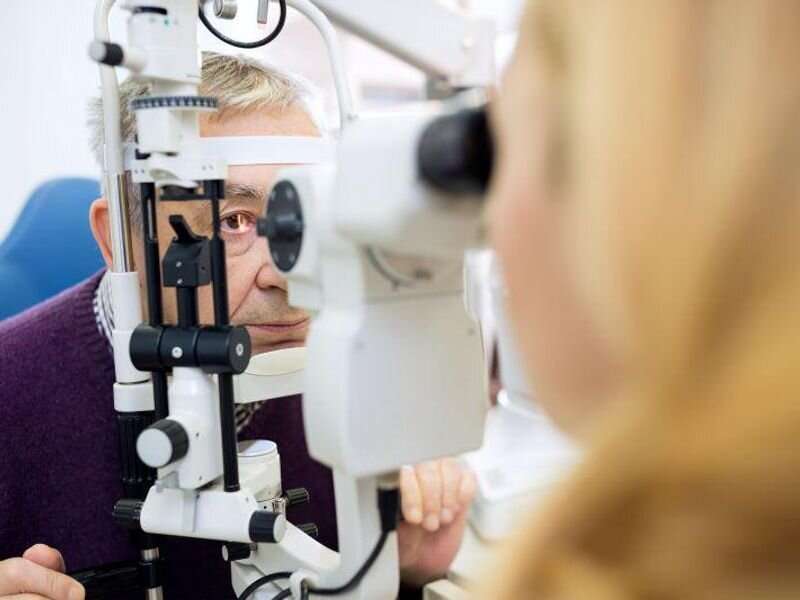This article has been reviewed according to Science X's editorial process and policies. Editors have highlighted the following attributes while ensuring the content's credibility:
fact-checked
peer-reviewed publication
reputable news agency
proofread
Almost 10 million Americans have diabetes-linked eye disease, finds new study

Nearly 10 million Americans are at risk for blindness from diabetic retinopathy, a new study finds.
In 2021, an estimated 9.6 million people in the United States—26% of those with diabetes—had the eye illness and nearly 2 million had the most severe form, "vision-threatening diabetic retinopathy" (VTDR), researchers say. That's 5% of those with diabetes.
"This finding illustrates the burden of this potentially vision-threatening complication of diabetes," said researcher David Rein, a senior fellow and director of the Public Health Analytics Program at NORC at the University of Chicago.
"This finding is driven primarily by the large increase in diabetes in the United States that has occurred over the last 20 years, and underscores the importance of prioritizing eye care and diabetic retinopathy screening among people with diabetes," he said.
Diabetic retinopathy affects the small blood vessels in the eye, explained Dr. Talia Kaden, an ophthalmologist at the Manhattan Eye, Ear and Throat Hospital in New York City.
"The small vessels in the eye can become damaged and abnormal, you can have a loss of blood supply to parts of the eye that can result in swelling in the back of the eye, bleeding in the back of the eye or the formation of abnormal blood vessels," she said. "If left unchecked, it can lead to vision loss."
An estimated 1 in 4 Americans aged 40 and older have diabetes-related eye disease—more than double 2004 levels, according to the study. The number of those living with VTDR has almost doubled, as well.
Among those 24 and under, more than 1 in 10 with diabetes had diabetic retinopathy as did nearly 1 in 5 among those 25 to 39 years of age.
The data come from the U.S. Centers for Disease Control and Prevention's Vision and Eye Health Surveillance System.
The findings revealed that the prevalence of VTDR is higher for Black (9%) and Hispanic (7%) individuals than white people (4%).
"This suggests that negative social determinants of health, such as poverty, lack of health care access, and likely poor diet and exercise are resulting in higher rates of diabetes, poorer glucose control among people with diabetes and greater rates of diabetes complications like diabetic retinopathy," Rein said.
Rates of diabetic retinopathy also varied by state from a low of 21% in Nevada to a high of 34% in Hawaii.
The researchers said they were not surprised to see the highest prevalence in some of the nation's poorest areas, particularly in the Deep South.
While prevalence of diabetic retinopathy and VTDR increased with age, the researchers noted that it decreased in older age. That's likely because these eye diseases are markers for more severe diabetes, which can lead to early death, they added.
Screening and early intervention for diabetic retinopathy are vitally important to preserve vision among people with diabetes, Rein and Kaden said.
"Every diabetic really should be seen by an ophthalmologist annually," Kaden said. "If there is something wrong in terms of whether or not they have new blood vessels formed or swelling, the frequency of visits can range from annually to every month."
There are some very effective treatments, she said, part of the reason it's so important for patients with diabetes to be seen regularly by a retina specialist.
For swelling in the back of the eye and sometimes for bleeding in the back of the eye, patients are treated with injections and medications, Kaden said.
"We also use lasers to try to prevent the formation of these abnormal blood vessels in the bleeding," she said.
One expert who wrote an editorial that accompanied the study said diabetic eye disease should be at the forefront of diabetes care. She urged both patients and their doctors to be proactive to prevent blindness.
"The need for eye care to prevent vision loss and blindness should not be ignored by patients, their health care providers nor by health policymakers," said Xiangrong Kong, an associate professor at the Wilmer Eye Institute, School of Medicine at Johns Hopkins University in Baltimore.
The study was published online June 15 in JAMA Ophthalmology.
More information: Elizabeth A. Lundeen et al, Prevalence of Diabetic Retinopathy in the US in 2021, JAMA Ophthalmology (2023). DOI: 10.1001/jamaophthalmol.2023.2289
Xiangrong Kong, Diabetic Retinopathy in the US—Where We Are Now and What Is Next, JAMA Ophthalmology (2023). DOI: 10.1001/jamaophthalmol.2023.2558
For more on diabetes-related eye diseases, visit Prevent Blindness.
Copyright © 2023 HealthDay. All rights reserved.





















